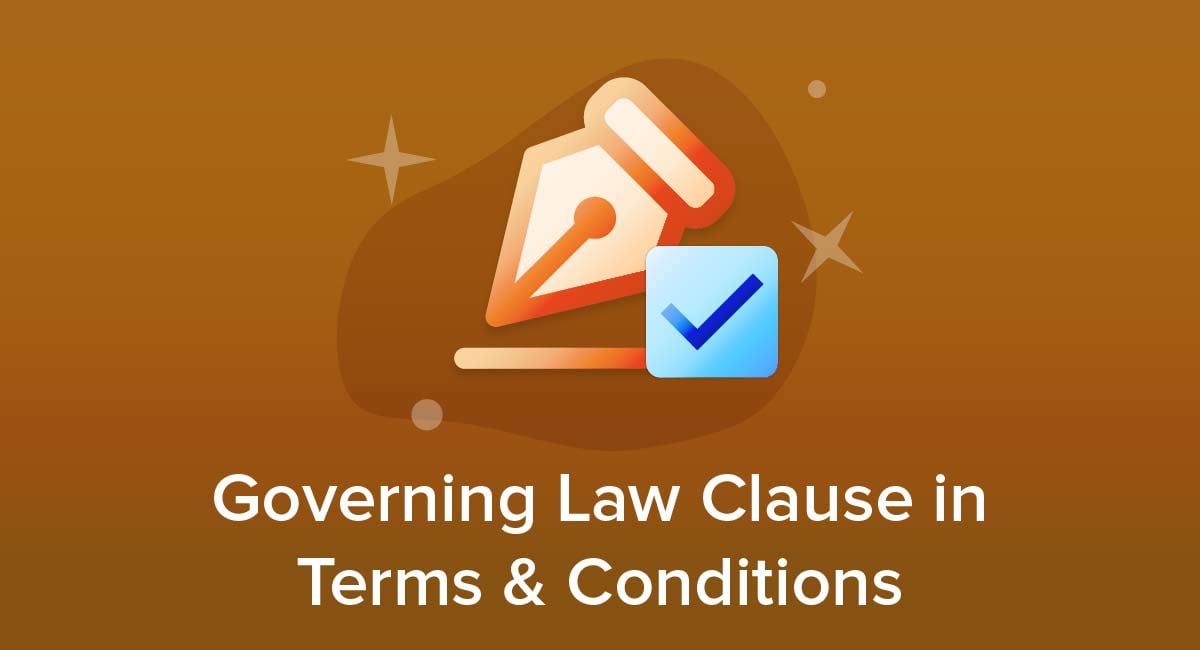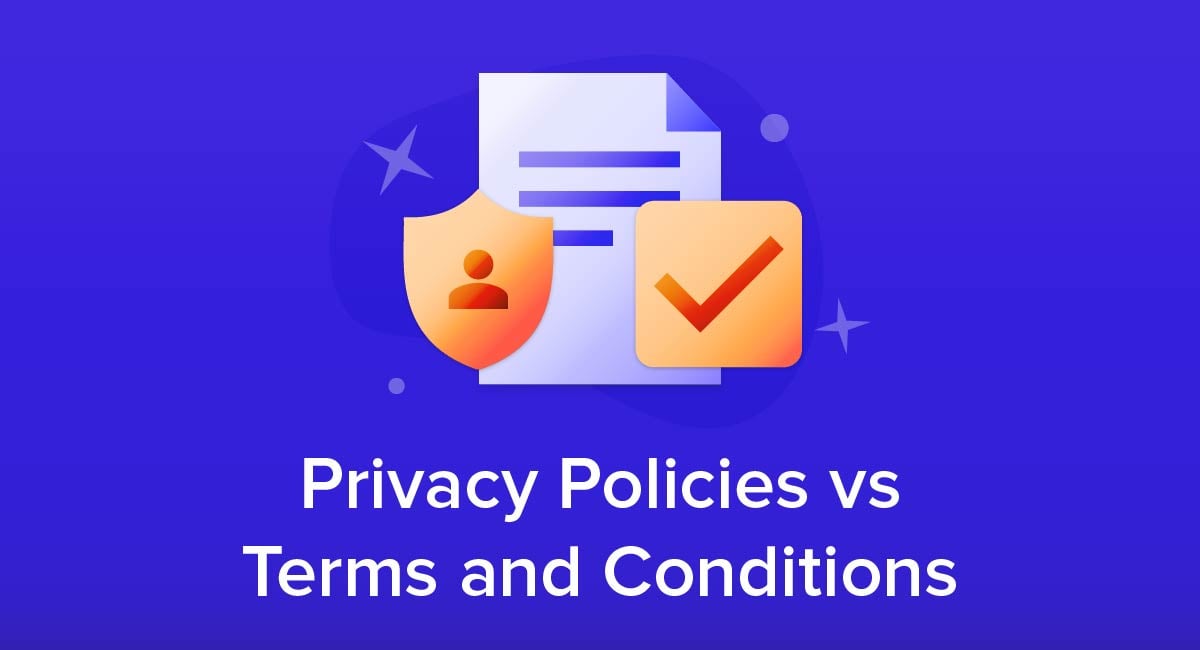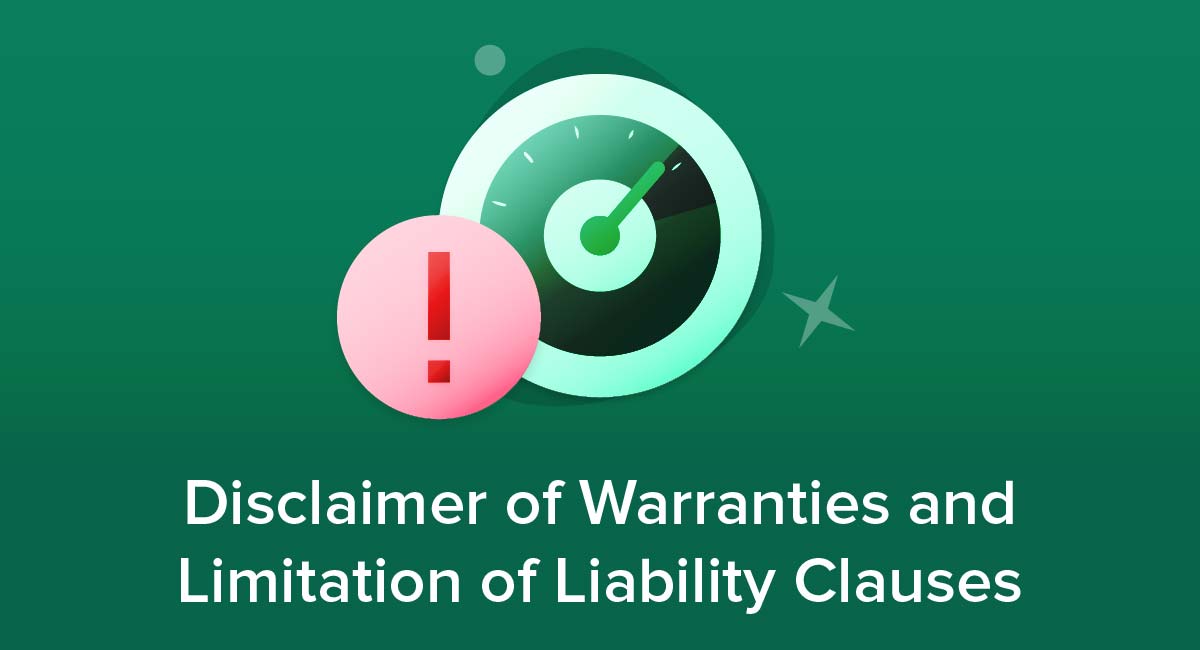
A disclaimer of warranties is about what the business does and does not promise, while the limitation of liability is about the business's responsibilities.
"Disclaimer of warranties" and "limitation of liability" clauses are almost universally included in Terms and Conditions agreements, particularly for businesses supplying goods and services. Though commonly grouped together, these clauses address two different points.
Together these clauses usually clarify points that might otherwise lead to problems if the two sides had different interpretations about what would happen in a given situation.
Let's take a deeper look at what these clauses are, what they do, and how you can create and display your own in your Terms agreement.
Our Free Terms and Conditions Generator is created to help you generate a professionally drafted agreement that can include various terms and conditions for your site and/or app.
- Start the Free Terms and Conditions Generator from our website.
- Select platforms where your Terms and Conditions will be used (website, app or both):
- Answer a few questions about your website or app information:
- Select the country:
- Answer a few questions about your business practices:
-
Enter your email address where you'd like to receive the new Free Terms and Conditions and click "Generate":
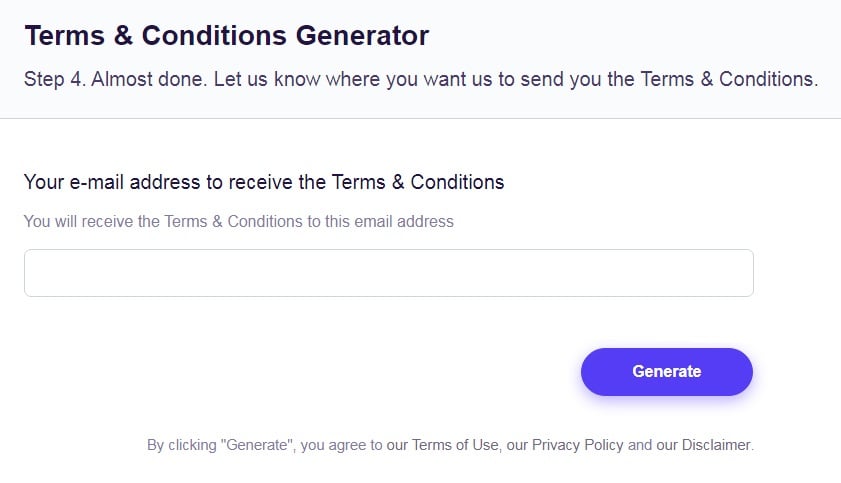
Once generated, you can copy and paste your Free Terms and Conditions agreement on your website or app or link to your hosted Free Terms and Conditions page.
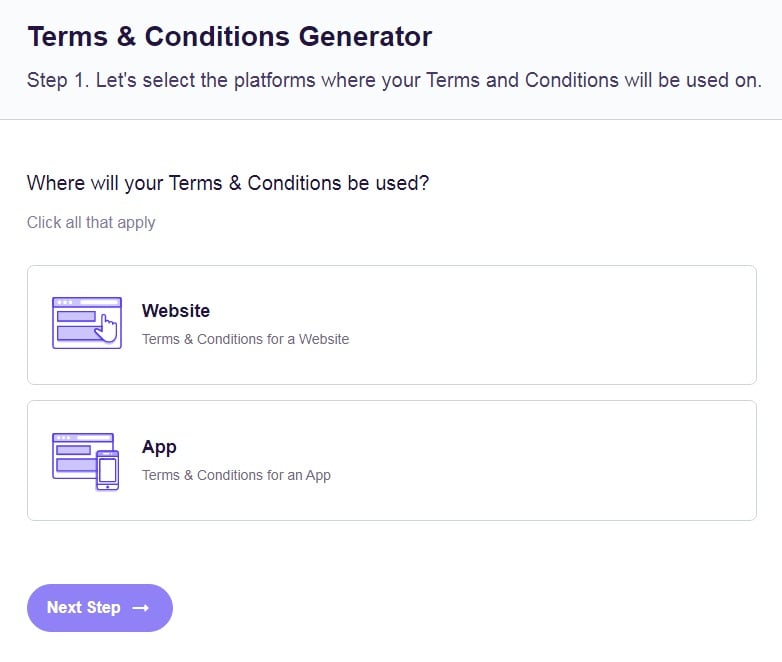
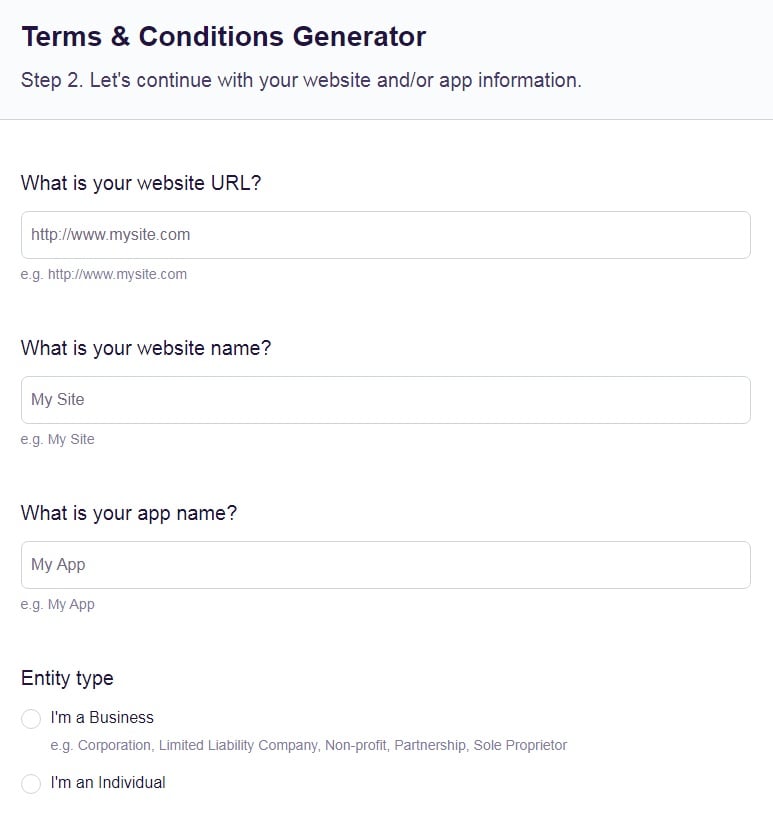
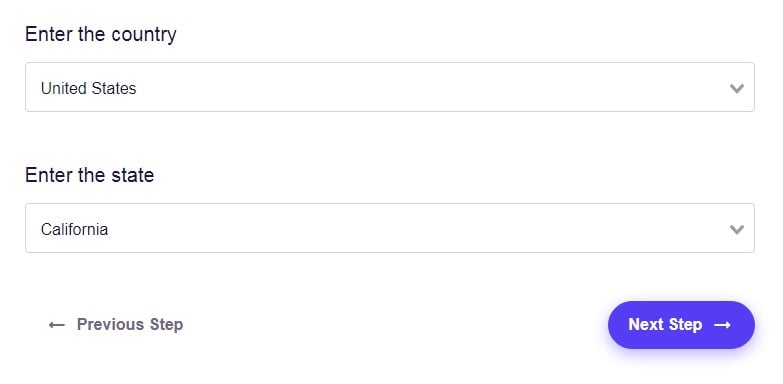
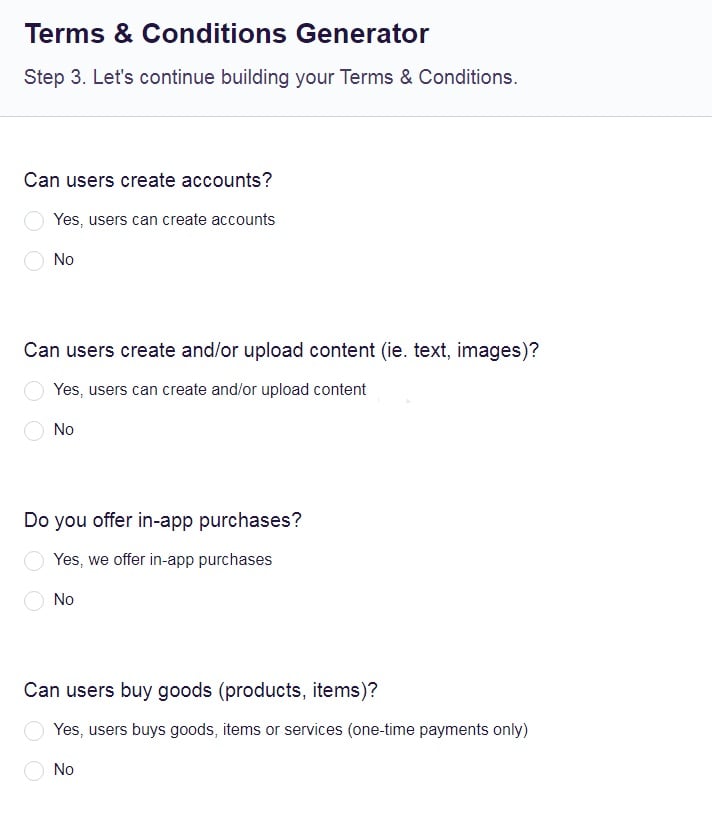
- 1. Disclaimer of Warranties Clauses
- 1.1. "As Is" Phrasing
- 1.2. "As Available" Phrasing
- 1.3. "Without Errors" Phrasing
- 1.4. "Express or Implied" Phrasing
- 2. Limitation of Liabilities Clauses
- 2.1. Accuracy
- 2.2. Damages and Losses
- 2.3. Financial Value
- 3. Legal Limitations on Disclaimers of Warranties and Limitations of Liability
- 4. Summary
Disclaimer of Warranties Clauses
"Warranties" are effectively promises or guarantees. They are important in a contractual context because if a court interprets that you made a warranty and failed to live up to it, it could conclude you have breached the contract.
It's key to understand what you are trying to achieve before you settle on the best wording for your disclaimer of warranties clause in your Terms and Conditions agreement. We've detailed some common phrases and their effects below.
A warranty could be an explicit promise, or it could be an expectation that the customer would reasonably have unless you stated otherwise. For example, if you sold a basketball, a customer would reasonably expect it to be spherical, even if you didn't explicitly say that was the case in your marketing.
"As Is" Phrasing
Disclaimers of warranty often use the phrase "as is," for example by saying services are supplied "as is." This can cause confusion as it sounds similar to situations such as buying a used car and not being able to complain about any faults that were present when you bought it.
Instead, "as is" in a disclaimer of warranty usually goes a step further and means the only warranties are those explicitly stated in the Terms and Conditions agreement. That leaves no room for inferred warranties or assumptions on the buyer's part.
Here's how Analog Devices ends its lengthy disclaimer of warranty with this phrase:
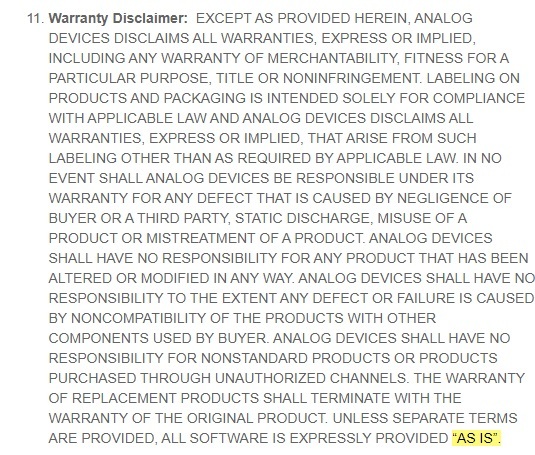
Now let's look at some other common phrasing seen in warranty disclaimers, and what they mean.
"As Available" Phrasing
The phrase "as available" usually means you are not giving a warranty that the goods or service will always be available. Another way to look at it is that you are giving a warning that they may be unavailable at some times.
The main reason to use such a phrase is to cover yourself against situations where you are temporarily unable to provide a service.
For example, a subscription section on your website could be unavailable because you have technical problems. Or, in a more outlandish case, if a foreign government blocks access to your site for its citizens.
Here's how Mews uses this phrase in its disclaimer:
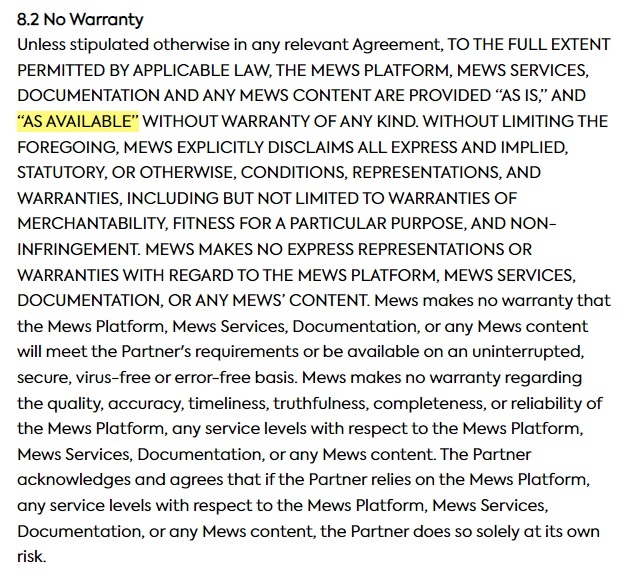
Next we'll look at a clause that addresses errors and mistakes of your content.
"Without Errors" Phrasing
Your disclaimer of warranties clause could make clear that you are not promising to provide goods or services without errors. Again, another way to look at it is that you are giving a warning that errors are possible.
Such a clause can be important when it comes to avoiding assumptions. For example, if you ran a website that lists the cheapest gasoline prices in the user's city, they might assume you are promising to always get the prices right. A "no warranty of service without errors" reference would make clear you are not making such a promise.
Here's how WebShopAssist makes it clear that it is not promising there will be no errors in its services:

And now let's look at the final most commonly used phrasing in a disclaimer of warranties clause.
"Express or Implied" Phrasing
Express warranties are promises you spell out in your Terms and Conditions agreement, such as a promise that a website will be available at least 95% of the time.
An implied warranty is one that somebody reading the Terms and Conditions could reasonably assume would apply, often based on consumer law, even though it isn't explicitly stated. For example, somebody buying a basketball might reasonably assume it will bounce on a standard basketball court, even though you haven't spelled out such a promise.
The most extreme warranty disclaimer is to say that you make no warranties "express or implied." In effect, you are saying that you are making no promises whatsoever.
Here's how Express Newspapers uses the phrase regarding the content of its publishing:

Now let's take a look at the limitation of liabilities clause and how it differs from the disclaimer of warranties.
Limitation of Liabilities Clauses

This clause is about restricting or disclaiming your responsibility, particularly for anything that could cause harm or damage to the buyer.
Again, different Terms and Conditions agreements use different phrases, so the key is understanding what liabilities you are trying to limit.
Accuracy
Such clauses often say the seller or service provider is not responsible for any mistakes or inaccuracies in the information they've provided. More specifically, they are disclaiming any responsibility for harm these inaccuracies cause.
In the previous example of mistakes in gasoline price listings, this would reduce or remove the risk of a user suing you to make up the difference because they "overpaid" for gas.
Some contracts or Terms and Conditions agreements use the phrase "errors and omissions excepted." This usually has a more specific meaning and applies to specific contract terms such as prices, quantities and delivery dates.
For example, you might mistakenly give a customer a quotation of $500 to replace an entire driveway when the correct price is $5,000. Including the "errors and omissions excepted" phrase means the customer will find it difficult to legally force you to do the work for $500.
Here's how Trace Heating uses an errors and omissions clause:

Damages and Losses
Such clauses often limit or exclude your responsibility for any damages you may cause. This could cover causes such as faulty goods, delays or failure to supply.
In other cases, this clause may not exclude responsibility for damages (for example, faulty goods causing personal injury or damaging other equipment), but will limit or exclude liability for losses. For example, this could mean a web hosting company saying it isn't responsible if a business loses orders because its website is unavailable.
Some clauses list different types of damage that the seller or service provider aims to exclude, for example damages that compensate the customer, damages that punish the seller or service provider, and damages for both direct and indirect harm.
Using a list can make it clearer that a particular type of damage is excluded, though it can be safer to highlight that the list is illustrative and non-exhaustive. This reduces the risk of the customer arguing that you are responsible for damage that doesn't fit into the types you have listed.
Here's how ATARA Design gives a specific example of where it excludes claims for damages:

Financial Value
Some clauses include a maximum liability figure. This acts as a backup protection and means that even if you are liable for a form of damage not covered by the various exclusions and limitations in the Terms and Conditions agreement, you will only have to pay a certain amount.
This maximum figure could be a flat amount or be related to the cost of the goods or services. For example, you could say you won't pay damages greater than the purchase price. In effect this means you'll give a full refund but no more.
Here's how Mimecast sets out its maximum liability based on the customer's payments:

Now that you have a good idea about the differences in content and purposes of these clauses, let's look at the limitations on how you can use these clauses to protect your business.
Legal Limitations on Disclaimers of Warranties and Limitations of Liability

Whether you are allowed to use particular forms of disclaimer of warranty or limitation of liability clauses will depend on your jurisdiction.
In many cases, rules on goods being as described and fit for purpose, or businesses being responsible for harm caused by faulty goods or negligence, may override any clauses in your Terms and Conditions agreement. This may be the case even though your customers have agreed to the terms.
To take account of this, such clauses often include a phrase such as "our liability shall be limited to the greatest extent permitted by law." This tells the customer that you are not making any promises or taking any responsibility beyond what you are legally required to do.
Some jurisdictions do allow you to disclaim particular warranties or limit particular liabilities but only if you highlight this clause in a particular way.
Depending on the rules, this could mean using bold text, capital letters, or printing in a bigger font than surrounding text.
The logic is to make it much clearer to customers that agreeing to the terms and conditions means giving up rights that would otherwise apply by default.
Summary
Let's recap what you need to know about disclaimer of warranties and limitation of liability clauses:
- Both clauses commonly appear in Terms and Conditions agreements, which work alongside contracts for specific sales or services
-
Disclaimer of warranties clauses highlight that you are not making specific promises:
- "As is" means you are making no promises other than those you specifically list
- "As available" means you aren't promising a service will always be available
- "No warranty of service without errors" means you are not promising there will be no errors
- "No warranties express or implied" means nobody should infer you've made a promise
-
Limitation of liabilities clauses limit or remove your responsibilities:
- "Accuracy" limitation means you aren't responsible for harm or damage caused by errors in the information you provide
- "Errors and omissions excepted" means you can't be bound by unintentionally incorrect information such as a quoted price
- "Damages" and "Losses" refer respectively to harm you've caused and to consequential loss the customer suffers because of your failure
- "Maximum liability" can limit your liability to a particular amount or a proportion of the sale price. This is usually a back-up against other disclaimers not holding
- Disclaimers of warranties and limitation of liabilities clauses may not be valid in every jurisdiction. Consumer law and health and safety laws could take priority even if the customer agrees to the terms.
- Some jurisdictions say certain disclaimers (such as those overriding default consumer law) only apply when highlighted and emphasized in a particular way, such as with larger than standard type size.
